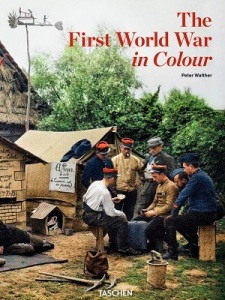Once again I have discovered something I consider extremely interesting, although I am not certain how many others will. Yes, it’s that fascination I have with World War I. We can all probably rattle off at least five or ten items created as a result of World War II, such as penicillin and synthetic rubber and the atomic bomb. There’s even a website that lists the ten most significant discoveries in someone’s opinion.
But I have, and many others before me, found very significant items and events we take for granted that came about between 1914 and the 1919 victory celebrations. A book I recently purchased inspired this new interest. It is The First World War in Colour by Peter Walther. No, that’s not a misspelled word; it is the British version of our word color. Since the book was published in Great Britain, I felt I should use their spelling.
It seems that as early as the 19th century the technique for making photographic prints in color was somewhat well-known but the process was extremely time consuming and expensive. By 1902, professional use of color photographs was more common in large cities. A new technique developed in 1907 called autochrome would be used by amateur photographers, including those soon off to the European battlefields. The process was still lengthy and many of the images were composed rather that spontaneous. Capturing colored images must have taken longer than black and white, although some of those were staged. However, the extent of wartime devastation was so appalling, no matter how long it took to develop the film or how staged the photograph was, the person looking at the photograph was shocked.
In the last few years Peter Walther collected more than 320 colour photographs from archives in Europe, Australia, and the United States for his book. Two photographs really surprised me. I was always under the impression that the United States wanted no part in the war, citing the Monroe Doctrine. However, we sent U. S. ambulances to the Western Front for the Entente (Great Britain, France, and Russia) as early as the Battle of Verdun. The participants fought from February to December 1916 and neither side gained significant ground.
So what are other significant new inventions created in the period of World War I? Try wristwatches, no one had time to pull out a pocket watch when he could look on his arm. Pocket hankies or tissues we use so often, sun lamps to treat children with rickets, and daylight savings time were new and probably the greatest things around at the time. Other new inventions include tea bags, zippers, and stainless steel as used in eating utensils and many more important items. The list is much longer.
What new customs or policies were introduced here in the United States? Two issues actually led to Constitutional Amendments. The United States had very few military training posts. Ones built quickly were not in the better parts of towns. Mothers who worried about their young sons morals were highly enraged to find liquor and red light districts readily available around the military bases. This led to legislation outlawing prostitution. It added fuel to the continuing arguments for Prohibition.
The second issue was women’s suffrage. In some states during World War I, married women could vote for their husbands. Once those women were able to cast their ballots there was no turning back. Both Prohibition and Suffrage Amendments were passed shortly after the end of the war. Out of tragedy of war often comes some good.

